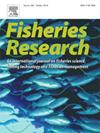Distribution, life history traits, and ecological significance of bigeye sculpin Triglops nybelini (Cottidae) in Siberian Arctic marine ecosystems
IF 2.2
2区 农林科学
Q2 FISHERIES
引用次数: 0
Abstract
The bigeye sculpin Triglops nybelini (Cottidae) is a widespread and abundant species in the Arctic and the adjacent North Atlantic playing an important ecological role in marine ecosystems. Consuming pelagic and benthic invertebrates and being prey for predatory fish and marine mammals, this species participates in the transfer of energy and organic matter between the lower and upper trophic levels. As a key part of a food web, bigeye sculpin indirectly supports some commercially important fishery resources. In addition, this species is a competitor for the food with polar cod Boreogadus saida and some other sculpins. Meanwhile, the data on its ecology and biology in the Arctic seas remain poorly understood, while there is almost no such data for the Laptev Sea (Siberian Arctic). Habitat characteristics and biological features of the Laptev Sea bigeye sculpin are presented for the first time. This species has been observed throughout the lower shelf and upper continental slope within the entire studied depth range of 110–752 m at bottom temperatures ranging from −1.30 to + 1.38°C. The relative abundance (density) was within 21–653 inds./km2. Although dense concentrations of this species have not been observed anywhere, its maximum catches have been recorded within the 550–750 m depth range, which is somewhat deeper than published data on the optimal depths. Individuals aged 3–5 years with a total length of 66–110 mm and a body weight of 2–8 g dominated the studied samples. This species in the Laptev Sea is characterized by the presence of sexual dimorphism in the external morphological characteristics and sizes of mature males and females. Among the fish longer than 95 mm, the proportion of females increased sharply, reaching 100 %, with a total length > 100 mm. Despite the relatively diverse diet composition, the bulk of the diet (89 %) of the bigeye sculpin in the Laptev Sea was composed only of hyperiids and euphausiids concentrated within the near-bottom layer. As the size of this species increases, benthic organisms almost completely disappeared from its diet, and only hyperiids and euphausiids became the main prey. This may suggest that unlike many other sculpins, T. nybelini is a benthopelagic fish.
西伯利亚-北极海洋生态系统中大眼雕鱼的分布、生活史特征及生态意义
大眼雕鱼是北极及邻近北大西洋地区分布广泛、数量丰富的物种,在海洋生态系统中起着重要的生态作用。该物种以中上层和底栖无脊椎动物为食,是掠食性鱼类和海洋哺乳动物的猎物,参与能量和有机物在低营养层和高营养层之间的转移。作为食物网的关键部分,大眼雕间接支持了一些重要的商业渔业资源。此外,这个物种是与极地鳕鱼和其他一些雕塑的食物竞争对手。与此同时,北极海域的生态和生物学数据仍然知之甚少,而拉普捷夫海(西伯利亚北极)几乎没有这样的数据。首次介绍了拉普捷夫海大眼雕的生境特征和生物学特征。在110-752 m的整个研究深度范围内,在−1.30至+ 1.38°C的底部温度范围内,整个下陆架和上大陆斜坡都观察到该物种。相对丰度(密度)在21-653个/km2以内。虽然在任何地方都没有观察到该物种的密集分布,但在550-750 米深度范围内记录了其最大捕获量,这比公布的最佳深度数据略深。以3 ~ 5岁的个体为主,体长66 ~ 110 mm,体重2 ~ 8 g。拉普捷夫海的这一物种的特点是在外部形态特征和成熟雄性和雌性的大小上存在两性二态性。在长度大于95 mm的鱼中,雌鱼的比例急剧增加,达到100 %,全长>; 100 mm。尽管饮食组成相对多样化,但拉普季夫海大眼鱼的大部分饮食(89 %)仅由集中在近底层的双歧鱼和偏歧鱼组成。随着该物种体型的增大,底栖生物几乎完全从它的饮食中消失,只有双生虫和大腹虫成为它的主要猎物。这可能表明,与许多其他雕塑不同,T. nybelini是一种底栖鱼类。
本文章由计算机程序翻译,如有差异,请以英文原文为准。
求助全文
约1分钟内获得全文
求助全文
来源期刊

Fisheries Research
农林科学-渔业
CiteScore
4.50
自引率
16.70%
发文量
294
审稿时长
15 weeks
期刊介绍:
This journal provides an international forum for the publication of papers in the areas of fisheries science, fishing technology, fisheries management and relevant socio-economics. The scope covers fisheries in salt, brackish and freshwater systems, and all aspects of associated ecology, environmental aspects of fisheries, and economics. Both theoretical and practical papers are acceptable, including laboratory and field experimental studies relevant to fisheries. Papers on the conservation of exploitable living resources are welcome. Review and Viewpoint articles are also published. As the specified areas inevitably impinge on and interrelate with each other, the approach of the journal is multidisciplinary, and authors are encouraged to emphasise the relevance of their own work to that of other disciplines. The journal is intended for fisheries scientists, biological oceanographers, gear technologists, economists, managers, administrators, policy makers and legislators.
 求助内容:
求助内容: 应助结果提醒方式:
应助结果提醒方式:


